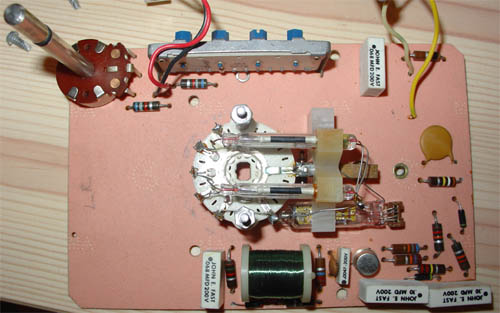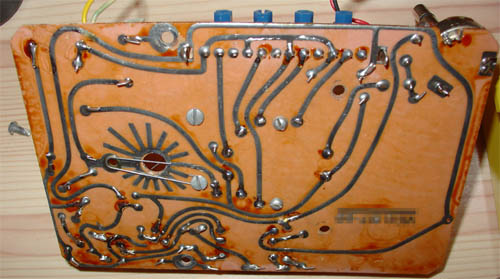The Ware for February, 2006, is shown below. Click on the image for a much lager view.
Ah, there is nothing like the last minute to get you motivated. If I waited another hour, I couldn’t call this February’s ware!…oh, in fact, since my server is on the East Coast, the post time already says March 1st. :-P Unfortunately, the ware I really wanted to post this month isn’t ready yet, so you’ll have to stand by until next month. This one, however, is still pretty neat, I think.
I’m guessing someone out there may be able to guess this one outright, but in case it turns out to be a tough one, I have one more picture (a sensor assembly) that I can give out as a clue that should give away what it is. It’s a pretty old piece of equipment (includes a sticker with the complete schematics of the assembly inside the case!), but still a neat thing to have around if not just as a conversation piece and to own a small piece of history.


Hmm… okay. Something tells me this was made way before I was born :)
let’s see… pot in the upper left, four trim pots on the top, handful of resistors and capacitors (“John E. Fast & Company” seems to be a now-defunct manufacturer). The can at the bottom looks like it has a TI logo on it, but I can’t make out the rest of the markings. There’s a choke, too (right?)
And of course the middle assembly… which really reminds me of the old Honeywell thermostat that used to be above my bed when I was a kid — the old tilting-mercury-switch kind. I have no clue what those two horizontal bars are–come to think of it, are there four? Are they high-rated resistors or something like that? And below that… fuse or bulb?
I’m going to take a wild stab here and say it’s a tester of some kind? I have no idea what for though…
Ugh! I can’t stop looking at this thing.
I’m pretty sure those glass bits are resistors, and they’re probably a sensativity setting, or something like that; as far as the top pots go… calibration. It looks like each pot is wired up to one of those glass resistors. I assume the thing in the can is a transistor, simply because that strikes me as a pretty high-tech(-looking) package for when this board was made.
Some googling later, I think I have it pretty nailed as to what it is, but I’ll SHA1 it:
a4f503ec5668fd3afbba0b4528a511efe69dda30
To be even more specific:
ab8401f21df7246dcea58f0ca77828c21cd2a791
It looks much like my a4f503ec5668fd3afbba0b4528a511efe69dda30 with a couple of newer parts substituted. The resistors on mine are ceramic if memory serves, and the part with wire wound round it is covered in apparently waxed paper and squarish rather than on an exposed round bobbin. The additional 2 wires also differ.
The sensor on mine just looks like a round metal box with a flange, so I wonder what the new-style sensor looks like that would give anything away. Now that I think of it, I don’t see the type of sensor connection that I remember mine having (2 screw holes near a short edge of the board for gnd/mounting and a through hole for the other pin). I doubt whether those extra two wires are for the sensor.
I believe the glass tubes are, as bdb guessed, resistors. We use an identical-looking high-precision resistor part on a current integrator for gamma ray detection that we designed where I work.
Looks like a control board for an old PTAC unit, the center looks like a thermostat control, the top has the limiter switches, and the upper left POT would be the selector.
bearcat — can you please repost your sha-1 hashed answer but add a trailing space to the plaintext prior to hashing? your hash is identical to bdb’s, which introduces some interesting complications in the judging process :) it’s quite likely that you both have the correct plaintext answer, but humor me since this points to the flaw in the scheme of hashing answers…two correct identical answers will hash to the same number, and that’s indistinguishable from simply copying someone’s hash and re-iterating it in a post. Since all the posts here are world-readable…well, you get the conundrum. I guess it also means you could run a rainbow table attack on the competition or something if you cared that much. :-P
The central glass thingy is a vacuum tube, most likely a simple triode. I imagine the grid pin is the one that goes to the wiper contact on the switch wafer.
This looks like some sort of input amplifier stage for very high-impedance instrumentation, most likely a cathode follower. If built nowadays, an insulated-gate FET would probably be used in place of the tube.
The sensor would be a big clue. Without it, I’m going to guess that this is the input amplifier from a pH meter.
You can add a “salt” to the hash…basically, make people include their name and timestamp to the hash, which should make forging via copying difficult.
People there got it right: it’s a a4f503ec5668fd3afbba0b4528a511efe69dda30 (sha1) or if you prefer de6138357b65ef89fcd4477f6da70af2 (md5) .
I saw one of them open a month ago in a little lab museum.
Sorry about the reasoning but my museum visit spoiled me and the glass high precision resistors wired with the calibration pots were very telling.
People there got it right: it’s a a4f503ec5668fd3afbba0b4528a511efe69dda30 (sha1) or if you prefer de6138357b65ef89fcd4477f6da70af2 (md5) .
I saw one of them open a month ago in a little lab museum.
Sorry about the reasoning but my museum visit spoiled me and the glass high precision resistors wired with the calibration pots were very telling.
Hmm… Could also be one of those old “Civil Defense specials” — beta/gamma rate meters. I’d expect the sensor to be an ionization chamber of some type. It looks a little too mass-produced to be a laboratory instrument. Whoever built this didn’t spend any more money than they had to.
With an added trailing space, it’s a d24314857c900f6783b27596e4ba8a4253053e39 . I wanted the hash to match the existing post so at least someone would know what I was talking about, and I figured that using the identical plaintext would help; I knew I wasn’t first.
I found mine, and the schematic label has gone missing. Feh. ISTR the tube was a pentode.
Sorta reminds me of the inside of one of the obsoleted Yellow Civil Defense Geiger counters. The pots on the side are a dead on match for the one I have. I’d like to re-activate the one I have, they did something to neutralize them from working before they threw them on the surplus market.
The glass thingys are vacuum carbon resistors for sure.
And I think there are 4 of them.
The missing component can’t be a GM tube, can it?
I though GM tubes only have 2 leads?
No thick track/wire for cathode heater.
looks like there are a few grids/screen thingys connected to the 4 pots, and the glass resistors.
Could it be a photo mulitplier?
but only 4 dynodes?
Seems like the socket of floating, pins don’t match, haha.
took me half an hour to see that.
That small tube has 5 leads, a triode sounds about right.
One single solid state component, TO-5 Metal can?
6 leads transformer, hooked up to the transistor, a feedback oscillator?
I have no idea, haha.
Thanks bunnie for giving the winner title for last months name the ware.
Does this card adjust the beam intensity for your SEM?
John E. components… I guess it stands for John Ericsson, the Swedish Telephone Manufacturer. So, I thought the device is telephonerelated. Maybe a testing device for phone workers?
honeywell…
air filter honeywell honey well…
Help! I don’t speak “d24314857c900f6783b27596e4ba8a4253053e39” would you care to tell a doddering old man what this device is?
Thanks,
pierre
When it is time for you to choose your k&n air filter it really does pay to do lots of research